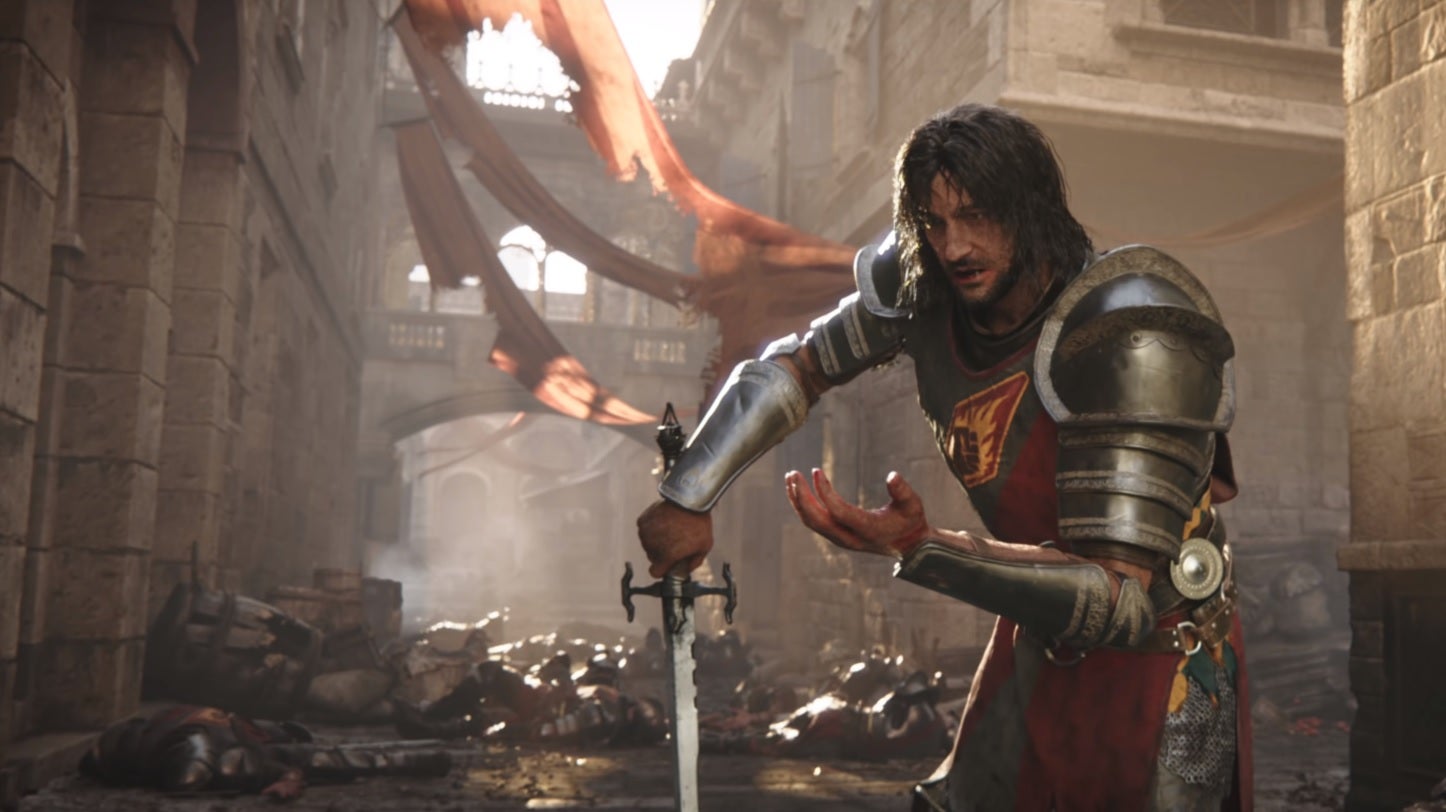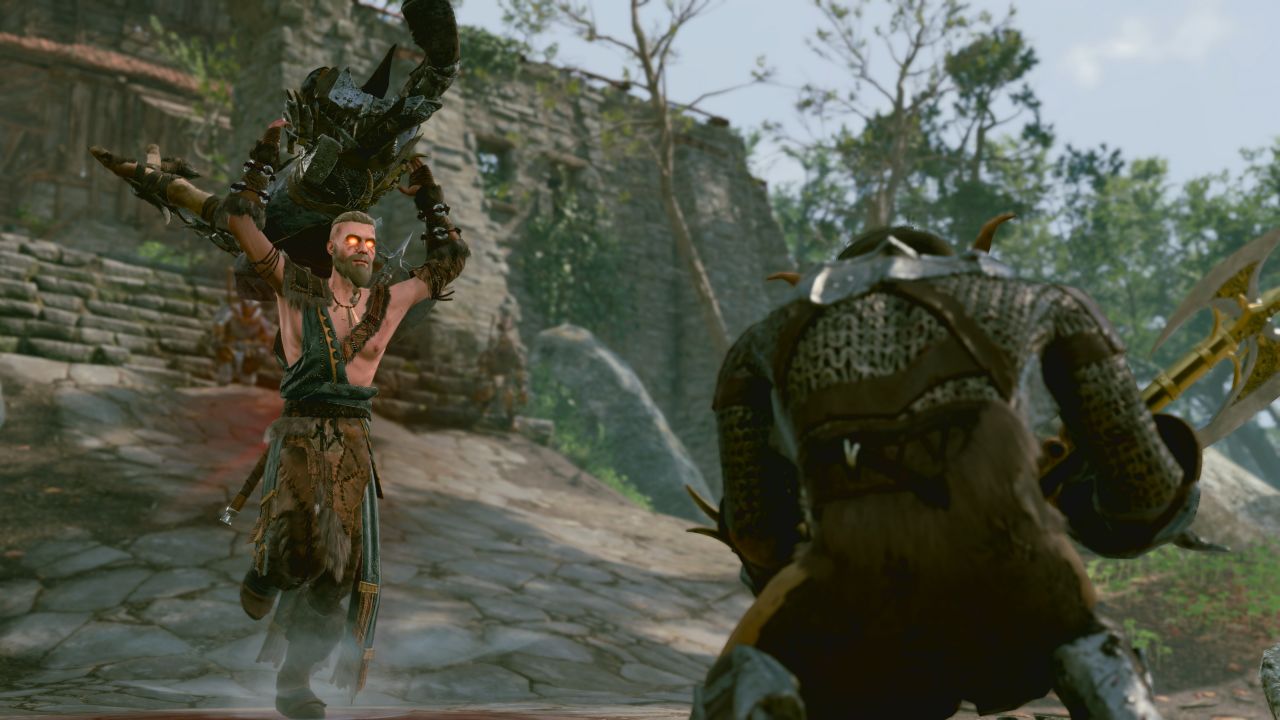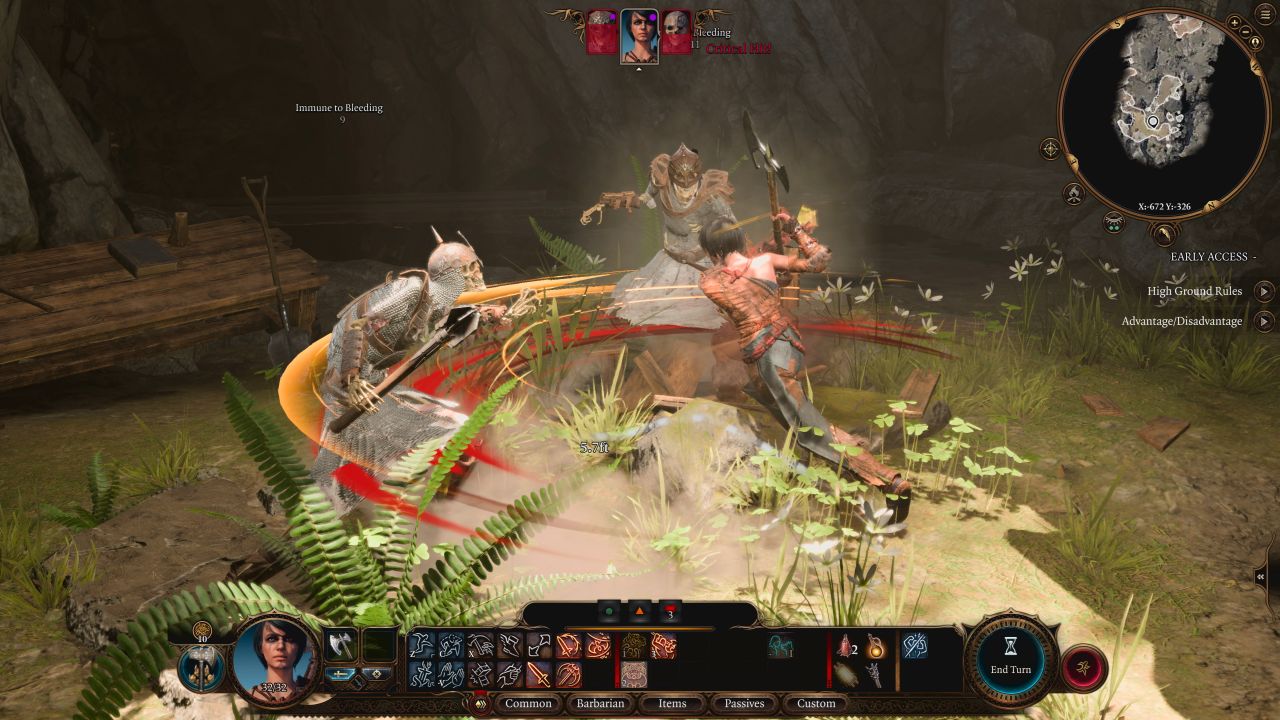“Second edition didn’t have the barbarian class,” remembers lead designer James Ohlen. “Baldur’s Gate 2 used third edition classes, but by then, it was too late.” Larian Studios, the current custodians of the series, don’t have any such issues. Working with D&D’s fifth edition, which has full and flavoursome rules that allow players to embody barbarians, the developers have adapted the class for use in Baldur’s Gate 3. It’s a typically meticulous transposition that holds true to the tabletop game’s definition of what makes a barbarian boil: “More than a mere emotion, their anger is the ferocity of a cornered predator, the unrelenting assault of a storm, the churning turmoil of the sea.” Raging is a way of life for barbarians, and a signature ability you can activate in combat using Rage Charges. Since you only get a handful of those per rest, the smart play is to sustain that rage for as long as possible, either by hitting something during your turn, or being hit by something. “That means that if you’re not going to manage to reach an enemy for whatever reason, your best tactic is having somebody else from your party hit you,” explains Larian CEO Swen Vincke. “Just so that you can keep raging. It’s very, very, very powerful.” Sustained rage might be more easily achieved by setting up a Twitter account, but there’s something evocative about the idea of a barbarian as an old boxer, imploring their coach to slap them across the face before the next bout - anything to get the blood up. While raging, barbarians do more damage, and halve the damage they sustain. During a demo of what’s coming later today in Patch 7, Vincke gets into a scrape with two goblins - one of whom, a ranger, immediately summons a spider. What did we say about that class coming with benefits? In response, Vincke makes use of the barbarian proclivity for improvised weaponry. “Improvised Weapons basically means that if you’re strong enough to pick it up, you can use it to hit something,” he explains. The CEO directs his githyanki main to grab the other goblin and swing it like a club, damaging both spider and goblin in the process. The enemy ranger has, rather wisely, kept their distance, so Vincke asks a second barbarian to hurl the summoner into the fray. No dice; at 120 kilograms the target is too heavy. If only they were an undead goblin. Less meat on the bones. No matter, though. Vincke commands the barbarian to down a Potion Of Hill Giant Strength, like Popeye. This is Baldur’s Gate 3’s design philosophy: no system existing in a vacuum, instead open to the influence of whatever tool you might have rattling around in your pack. With newly bulging muscles, the barbarian hurls the hapless gobbo, which lands atop the spider, flattening it. “I killed the summon with the summoner,” declares Vincke, proudly. As the dust settles, Vincke’s two barbarians level up, which means it’s subclass time. The githyanki main becomes a berserker, which transforms Rage into Frenzy. “In addition to all the normal bonuses that you get with Rage, you’re also going to get extra actions - in this particular case, Frenzied Strike, Enraged Throw, and Improvised Weapon attack,” says Vincke. “I get to double the damage, essentially, as a barbarian.” It seems no coincidence that these bonus actions encourage you to weaponise the world around you, lifting objects and enemies off the ground like an incensed litter-picker. For the backup barbarian, Vincke picks out the Wildheart subclass. That allows you to speak to animals, and double-down on your connection to a specific species. Select Bear Heart, and you’ll become tougher and tankier; Elk Heart, and you’ll gain the Primal Stampede ability, trampling straight through the enemy. With a Tiger Heart, you’ll jump higher and enter a bloodlust, lashing out and lacerating multiple enemies; with a Wolf Heart, you’ll start a new career as a motivational howler, buffing the movement speed and attack rolls of your allies. Wolves are the after-dinner speakers of the animal kingdom. This time, though, Vincke goes with Eagle Heart, specialising in dodging and dashes. “What’s the net result of this? I can basically move through the battlefield without risking too many opportunity attacks and get where I want to be, changing the battlefield by repositioning my character,” he says. Most entertainingly, the Eagle Heart barbarian channels Assassin’s Creed with an ability called Diving Strike, best exploited by finding a high vantage point and jumping onto an enemy, knocking them down, “which is pretty good as an opening move.” Vincke attempts to demonstrate this by staging an ambush. His victims are a trio of ogres, led by an unusually eloquent fellow wearing a Warped Headband Of Intellect, named Lump the Enlightened. As the three monsters discuss dinner in a dilapidated house, Vincke positions his Eagle Heart barbarian up in the rafters, along with a druid masquerading as a big, brown bear. “I just like my bear-sneaking,” he protests. He leaves the bear lounging nonchalantly on an exposed beam, though not necessarily for tactical reasons: “It makes me think of my dog.” Down below, the githyanki berserker strolls in to engage the ogres in conversation, albeit briefly. Vincke soon plumps for a barbarian-specific intimidation roll. If you like your dialogue reduced to growls and roars, you’re going to be happy with the options on show. Lump is a world-class debater by comparison. The githyanki says what he means to, however, when he picks up a chair and lobs it at Lump, like a cowboy in a saloon fight. In the roofspace, despite the planning, things soon go awry. A pre-release bug robs the Wildheart barbarian of her Diving Strike. Then an ogre smashes through a pillar, collapsing the floor above and bringing the bear down with it. At this point, the demo devolves into laughter. “I’ve never seen that before,” Vincke says. “Unbelievable. I didn’t know that was in there. Oh my god, that’s great.” Nevertheless, Vincke’s barbarians come out on top, helped behind the scenes by complementary sets of gear. One is kitted out head to toe in armour that bestows a new ability, Wrath. “It basically means that if you get hit, you’re going to do extra bonus damage,” Vincke says. The Wrath triggers in different contexts, depending on the item: after dashing, for instance, or when you’re reduced to less than half health. Worn together, these items mean you’re “wrathing a lot”. You’ll find sets of matching magical equipment scattered across the world of Baldur’s Gate 3, and they’re the only way you’ll get access to Wrath in particular. “They’re all very hand-tailored,” Vincke says. “By the time this game is gonna ship, there are gonna be a lot of magic items for each class.” Noticeably, the Wrath-specific items reward the taking of risks. It’s a subtle way in which Larian train players to use barbarians, courting damage to maintain that rage. While we’re taking inventory, so to speak, it’s worth exploring Larian’s newly powerful UI. The developers have installed filters in the menus that allow you to chase down weapons your character is proficient in, or every helmet you own, or potions that improve strength. They have compacted screens like the character sheet, and introduced the ability to “mix and match” screens so that you can, for example, show one character’s equipment alongside another’s stats. “When you play with it,” Vincke says, “it feels less claustrophobic.” These are quality-of-life touches rather than a headline features that sell games, but given just how many hours players burn scrutinising inventories in Larian games, these strike me as development hours well spent. The new UI is indicative, too, of what makes Larian stand out: a commitment to maximalism. Another studio might see a cavernous inventory - one that takes a search bar to navigate, no less - as a sign that their game has too much going on. They might take it as a cue to cut back and focus. But Baldur’s Gate 3 is not that game. Its mission is to offer the wide sprawl of fifth edition D&D and let players have at it, tackling Faerûn’s problems with whatever tool they see fit. The barbarian, to whom I have devoted hundreds of words? They may never join your party, in hundreds of hours of play. Larian is aiming for a game that is endlessly malleable, a radiant pool of options you cannot possibly see the bottom of. And that, surely, is the beauty of this daft, breathtaking project. Disclosure: Adam Smith (RPS in peace) used to work here but left RPS to be a word goblin at Larian. It is possible that some of the barbarian yelling was written by him.



